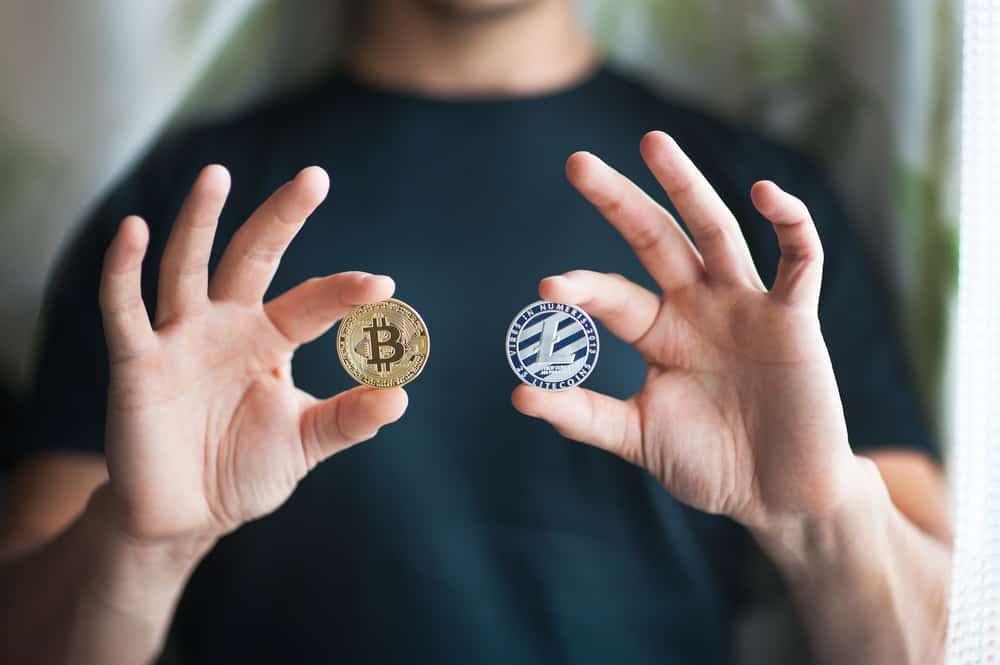Cryptocurrencies have revolutionized the world of finance, and two of the most prominent players in this space are Bitcoin and Litecoin. While each has its unique features and benefits, there has been a growing need for interoperability between different blockchain networks.
This article explores the concept of “Litecoin Latch,” an innovative solution that aims to bridge the gap between Bitcoin and Litecoin, enabling seamless transfers and interoperability between these two popular cryptocurrencies.
Want to make profitable trades in Bitcoin? Head over to immediate-trader and start trading, regardless of your prior experience in the field.
Overview of Bitcoin and Litecoin
1. Bitcoin
Bitcoin, often referred to as digital gold, was the first cryptocurrency to emerge in 2009. Created by an anonymous entity known as Satoshi Nakamoto, Bitcoin introduced the world to the concept of decentralized digital currency.
It relies on a proof-of-work consensus mechanism, where miners secure the network by solving complex mathematical puzzles.
2. Litecoin
Litecoin, often regarded as the silver to Bitcoin’s gold, was created by Charlie Lee in 2011. It shares many similarities with Bitcoin but offers some key differences, such as faster transaction confirmation times and a different hashing algorithm (Scrypt).
Litecoin has gained popularity as a reliable and efficient cryptocurrency for everyday transactions.
The Need for Interoperability Between Cryptocurrencies
As the cryptocurrency market continues to expand, the demand for cross-chain interoperability has become increasingly apparent. Users and businesses want the ability to seamlessly transfer assets between different blockchain networks.
Interoperability not only enhances the utility of cryptocurrencies but also opens up new opportunities for decentralized finance (DeFi) applications and cross-chain trading.
The Concept of Litecoin Latch
Litecoin Latch is an innovative solution designed to enable interoperability between Bitcoin and Litecoin. It leverages advanced blockchain technologies to create a bridge that connects these two cryptocurrency ecosystems.
In the following sections, we will explore how Litecoin Latch works and its potential impact on the cryptocurrency market.
Understanding Bitcoin and Litecoin
Below is an insight into the understanding of how Bitcoin and Litecoin work together
Bitcoin: The Pioneer of Cryptocurrencies
- History and Origin of Bitcoin
Bitcoin’s history is shrouded in mystery, with its creator, Satoshi Nakamoto, remaining anonymous. It was introduced in a whitepaper titled “Bitcoin: A Peer-to-Peer Electronic Cash System” in 2008. The first Bitcoin block, known as the “genesis block,” was mined on January 3, 2009.
- Key Features and Limitations
Bitcoin’s key features include decentralization, security through cryptographic techniques, and a fixed supply of 21 million coins. However, it also faces limitations such as scalability issues, high transaction fees during network congestion, and slower confirmation times.
Litecoin: The Silver to Bitcoin’s Gold
- History and Development of Litecoin
Litecoin was created by Charlie Lee, a former Google engineer. It was designed to address some of Bitcoin’s limitations while maintaining its core principles. Litecoin’s history dates back to October 2011, and it quickly gained popularity due to its faster block generation times and lower transaction fees.
- Comparative Analysis with Bitcoin
Litecoin’s Scrypt hashing algorithm allows for faster block generation (2.5 minutes compared to Bitcoin’s 10 minutes) and a larger total supply (84 million LTC compared to 21 million BTC). These differences make Litecoin well-suited for smaller transactions and day-to-day use.
Interoperability in the Cryptocurrency Ecosystem
The Importance of Cross-Chain Compatibility
Cryptocurrency interoperability is crucial for several reasons:
- Enhanced Liquidity: Interoperability allows assets to move seamlessly between different blockchains, increasing liquidity and reducing fragmentation in the crypto market.
- Expanded Use Cases: It enables the creation of complex DeFi applications, such as decentralized exchanges, lending platforms, and asset management tools that rely on multiple cryptocurrencies.
- Reduced Counterparty Risk: Users can transact across chains without relying on centralized intermediaries, reducing counterparty risk.
Existing Solutions for Cryptocurrency Interoperability
- Atomic Swaps
Atomic swaps are smart contracts that enable peer-to-peer trading of cryptocurrencies across different blockchains without the need for an intermediary. They ensure that either both parties receive their desired assets or neither party does, preventing fraud.
- Wrapped Tokens
Wrapped tokens are representations of one cryptocurrency on another blockchain. For example, Wrapped Bitcoin (WBTC) is a token on the Ethereum blockchain that represents Bitcoin. Users can trade WBTC on Ethereum’s decentralized exchanges.
- Cross-Chain Bridges
Cross-chain bridges are protocols or services that facilitate the movement of assets between blockchains. These bridges often rely on validators or custodians to hold and verify the assets on one blockchain while issuing equivalent assets on another.
Litecoin Latch: Bridging the Gap
What is Litecoin Latch?
Litecoin Latch is a cutting-edge solution that aims to bridge the gap between Bitcoin and Litecoin by enabling cross-chain compatibility and seamless asset transfers. It utilizes a combination of smart contracts and decentralized exchange (DEX) technology to facilitate interoperability.
The Technology Behind Litecoin Latch
- Smart Contracts and Scripting
Litecoin Latch relies on smart contracts, self-executing agreements with predefined rules, to enable secure cross-chain transactions. These contracts ensure that the conditions of the transfer are met before assets are swapped between chains.
- Decentralized Exchanges (DEXs)
Decentralized exchanges play a crucial role in Litecoin Latch by providing a trustless and secure platform for users to exchange assets between Bitcoin and Litecoin. DEXs eliminate the need for a central authority, reducing the risk of hacking or manipulation.
Advantages of Litecoin Latch
- Increased Liquidity
Litecoin Latch enhances liquidity in both the Bitcoin and Litecoin ecosystems by enabling users to move assets freely between the two chains. This increased liquidity can lead to more efficient markets and improved price discovery.
- Enhanced User Experience
Users can enjoy a seamless experience when transacting between Bitcoin and Litecoin, as Litecoin Latch simplifies the process of asset exchange. This user-friendly approach can drive wider adoption of both cryptocurrencies.
- Reduced Transaction Costs
By eliminating the need for intermediaries and providing a decentralized exchange platform, Litecoin Latch can significantly reduce transaction costs compared to traditional cross-chain transfers.
Use Cases and Applications
1. Cross-chain trading between Bitcoin and Litecoin
Litecoin Latch opens up new opportunities for cross-chain trading, allowing users to diversify their portfolios and access assets on both Bitcoin and Litecoin blockchains. This can be particularly useful for investors and traders seeking arbitrage opportunities.
2. DeFi Opportunities with Litecoin Latch
DeFi projects can leverage Litecoin Latch to expand their offerings and create decentralized financial products that incorporate both Bitcoin and Litecoin. This includes lending platforms, decentralized exchanges, and liquidity provision services.
3. Facilitating Faster, Cheaper Transactions
Litecoin Latch can facilitate faster and more cost-effective transactions for users who want to take advantage of Litecoin’s quicker confirmation times and lower fees while still benefiting from Bitcoin’s widespread adoption.
Challenges and Risks
1. Security Concerns
Any system that bridges two blockchains must address security concerns, including potential vulnerabilities in smart contracts and the risk of double-spending attacks. Robust security measures are essential to mitigate these risks.
2. Regulatory Hurdles
The cryptocurrency industry is subject to evolving regulatory frameworks. Litecoin Latch may face regulatory challenges, especially if it involves custody of assets or cross-border transactions. Compliance with local laws is crucial.
3. Scalability Issues
As Litecoin Latch gains popularity, it may encounter scalability challenges, similar to those faced by popular blockchains like Bitcoin and Ethereum. Ensuring efficient transaction processing is vital to maintaining a smooth user experience.
Future Prospects and Developments
Do you wish to discover the future of Litecoin latch? checkout our predictions below
1. The Potential Impact of Litecoin Latch on the Cryptocurrency Market
Litecoin Latch has the potential to reshape the cryptocurrency market by fostering greater interoperability and liquidity. Its success could encourage other blockchain projects to explore similar solutions, further enhancing the crypto ecosystem.
2. Integration with Other Cryptocurrencies
The lessons learned from Litecoin Latch could lead to the development of similar solutions for other cryptocurrencies. This could open the door to a broader network of cross-chain compatibility.
3. Community Involvement and Support
The success of Litecoin Latch will rely on community support and active development. Engaged developers, users, and stakeholders will play a crucial role in driving its adoption and continued improvement.
- Read Also: Benefits of Melding Bitcoin with Acala
Conclusion: Integrating Bitcoin and Litecoin
In conclusion, Litecoin Latch stands as a promising advancement in the realm of cryptocurrency interoperability. Its seamless integration of Bitcoin and Litecoin holds the potential to bolster liquidity, drive down transaction costs, and pave the way for new horizons in decentralized finance (DeFi) applications.
Nevertheless, Litecoin Latch must adeptly address security concerns, navigate complex regulatory landscapes, and tackle scalability challenges to fully harness its capabilities.
As the cryptocurrency ecosystem undergoes continuous transformation, pioneering solutions like Litecoin Latch provide a window into the future of blockchain technology, offering limitless possibilities.

Legacy Benjamin is a serial SEO content writer with a half-decade of experience in the field of blogging. He is also a skilled business consultant, providing valuable insights to companies and individuals seeking growth and success. His expertise lies in crafting compelling and engaging content that captivates audiences and drives business results. For business deals, contact him

